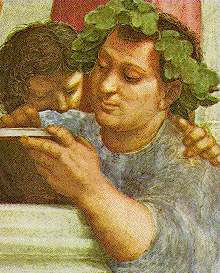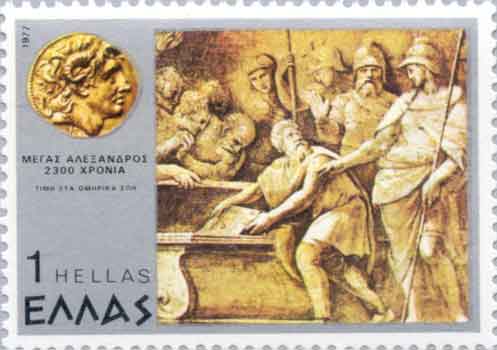.
Part 2
Raffaels Schule von Athen. Wer ist wer?
30 Pythagoras (Πυθαγόρας ο Σάμιος) ( 569/570 - c. 475 BC)
Pythagoras is represented by his theory of mathematical harmony on the left, Euclid by the perfection of Geometry on the right -- and the elaborate perspective design of the architectural setting seems to embody both. Pythagoras [and not the Evangelist Matthew according to Vasari in the 16th c. Pythagoras, representing Arithmetic, is sitting in the foreground. The two men who are jostling to look over his shoulder recall figures in Leonardo da Vinci's unfinished Adoration of the Magi in the Uffizi. Raphael had occasion to study Leonardo's picture during his stay in Florence. Probably Raphael used two Groups (one around Pythagoras) to show some early Philosophers with the somehow mysterious Pythagoras and the other group around Euclid (or Archimedes), Ptolemy etc. who represent more the clear true Science. A closer look at Pythagoras text, we recognize his most important discovery of harmony theory (music) and the numbers 1, 2, 3 and 4 which added together give the sacred number 10 (X). Epogdoon is a natural number which is 1/8 larger than a given number for example 18 is the Epogdoon of 16.



In harmony, diapason is the ratio of 2:1 between a pair of frequencies . The diapason is also called octave. The diatessaron is a ratio of 4:3 between a pair of frequencies. It is the harmonic mean of unison and diapason: Diapente is the ratio 3:2 between a pair of frequencies or, equivalently, the ratio 2:3 between a pair of wavelengths. It is the arithmetic mean of diapason and unison. In a diagrammatic representation of a lyra the strings are tuned in the relative proportions VI, VIII, VIIII, XII giving the intervals of an octave (diapason) between VI and XII, fifths (diapente) between VI, VIIII and VII, XII and fourths (diatessaron) between VI, VIII and VIIII, XII. The interval of a tone is present between VIII and VIIII. (http://www.midicode.com/tunings/greek.shtml#2.3 ) In contrast to the group around Euclid (or Archimedes) persons around Pythagoras stretch their head to see what Pythagoras is writing.



Drawing Steps: From paper to cardboard to the final fresco
(See Fresco Technique )
31 Anicius Manlius Severinus Boethius (480 Rome – c. 524-526 execution of Boethius) ?
Who is the old man who copies the words of Pythagoras? Probably Boethius, a person who with his work was influential in the Medieval times, with books such as Consolatio Philosophiae (The Consolation of Philosophy) written when he was in prison before his execution. Due to his knowledge of Greek he translated various astronomical and mathematical Greek texts which were important for the advance of Science in Europe.
Some say it is Empedocles, Zeno, Archytas of Tarentum, Iamblichus. But maybe also Anaximander (611 - 547 BC) (there are some similarities of this image with a sculpture of Anaximander), Terpander or Nicomachus or another musician and follower of Pythagoras.

32 Averroës (Abu Al-Walid Muhammad Ibn Ahmad Ibn Muhammad Ibn Ahmad Ibn Ahmad Ibn Rushd ) (1126 Cordoba - 10.12.1198 Marrakech /Morocco)

The philosopher of Cordoba Averroës identified by his turban. He was an author with commentaries to Aristotle's Metaphysics and On The Soul, Commentaries to Plato's Republic and many more other books about Philosophy, Astronomy, Medicine.
33 Federigo Gonzaga ?
Federigo Gonzaga ? second duke of Mantua, who was in Rome when the painting was executed, presumably identified by Vasari (16th c.)
34 Epicurus (Επίκουρος ο Σάμιος) (342-271 BC)

Epicurus (c. 342-271 BC) founded the Garden, a combination of philosophical community and school. The residents of the Garden put Epicurus' teachings into practice. "this man wears a wreath of oak leaves, the emblem of Pope Julius, to whose name Raphael dedicated the work signifying the golden age of this pontiff, his benefactor .(Some say that he is surrounded by a young and old man representing those who seriously followed his teachings.
35 ?
36 Zeno of Citium (c. 333- c. 262 BC)

Zeno of Citium the philosopher (c. 333- c. 262 BC) close to Epicurus. Or is it Zeno of Elea (c. 488 - c. 430 BC) ( The Paradoxa of Zeno ) sometimes assumed? Personally I would include the Elean Zenon just for his Paradoxa but Zeno of Citium was more influential and famous with his stoic philosophy.
37-38 ?
39 a servant comes running in haste, and he bears a volume on top of a book
40 ?
41 ?

Some say this is Aeschines.

42-46
42 Alcibiades (Αλκιβιάδης ) (c. 450 BC- 404 BC)

some assume to be Alexander the Great (Αλέξανδρος ο Μέγας ) only because a young man is shown with a helmet? What has Alexander to do with knowledge (except indirect as a important supporter). Should he not be closer to Aristotle?

Raphael already had included "Alexander the Great who honors the Work of Homer", in his Parnassus (Apollo and the Muses) fresco. Parnassus, The Disputa, The Cardinal Virtues and the School of Athens are the four frescoes he produced for the Vatican Stanza della Segnatura.The Meaning of the Camaieus under Raphael's Parnassus. In Mh. f. Kunstw. VIII, 1915, pp. 10-16 (5 figs.), G. J. HOOGEWERFP reviews the question of the interpretation of the two paintings en grisaille under the Parnassus of Raphael (Figs. 4 and 5) and concludes that the view of Bartsch, repeated by Wolfflin, is the only tenable one. The left camaieu represents Alexander having his copy of the Iliad deposited in the coffer of Darius; the right, Augus
43 Antisthenes (444 – after 371 BC) or General Xenophon (Ξενοφών) (c. 431/28 - c. 355/4 BC)?

Assumedby some to be Xenophon. a friend of Socrates, a mercenary warrior and author of books such as the Anabasis and Memorabilia. (Because he is close to the person who probably represents Alcibiades?). Another person it could represent is Antisthenes (444 – after 371 BC) the cynic philoshopher. For me his expression supports the Antisthenes hypothesis.
44 Aeschines (Αισχίνης) (c. 390 -322/14 BC)

Aeschines (c.390- 322/314? BC), son of Atrometus, Orator, with Socrates (what is he expressing with his hands?).
45 Socrates (Σωκράτης ) (469 - 399 BC)
Socrates (469 - 399 BC) as usually looks to discuss various philosophical problems (if we can call his method a discussion because actually he always speaks and the others say only yes or no or maybe ...)
Standing in alcoves on either side of the arch, the classical deities Apollo and Athena represent the supremacy of reason and the spirit over passion and the desires of the senses.
Left side

Natural philosophy side. Apollo god of healing. In the reliefs underneath: wrath and cupidity. Apollo can be recognized by his traditional symbol, the lyre. Is this sculpture actually representing the work of Michelangelo's Dying Slave? and if yes why?
Right side

Moral philosophy side. Athena with her shield, upon which the Gorgon is sculpted. The relief under Athena represents Virtue elevated upon the clouds.
Cardinal Farnese asked Giorgio Vasari to assemble "a catalogue of artists and their works, listed in chronological order". The result was 'The Lives of the Most Excellent Painters, Sculptors and Architects', first published in 1550 in Florence, and revised and extended for a second edition in 1568. Vasari tries to explain which persons are shown in the School of Athens Fresco. About Raphael he writes: “He was a very amorous man with a great fondness for women, whom he was always anxious to serve.”
The bones of Raphael were laid in a tomb since 1520, with an epitaph recording the esteem in which he was held by Popes Julius II. and Leo X.; but they have not always been allowed to lie undisturbed. On Sept. 14, 1833, the tomb was opened to inspect the mouldering skeleton, of which drawings were made...

Drawing of Skeleton of Raphael found in his tomb in the Pantheon, 1883 (Scientific American, 1883)
Other Versions of Raphael's School of Athens


The Stereoscopic pair: Athens is Burning. Left: The School of Athens, Right: The Fire in the Borgo, Salvador Dali.

The School of Athens extended as time advances... 1977 stamp, In front authors, winner of the Nobel Prize of Literature.
Raphael's School of Hollywood
Susanne Albers provides a modern version of Raphael's School of Athens, not of philosophers but film stars: Charlie Chaplin, John Wayne, Marlene Dietrich, James Dean, The Marx Brothers, Marylin Monroe, Elvis Presley, Woody Allen, Arnold Schwarzenegger, Marlon Brando, Donald Duck, Fred Astaire, “ET”, “Pretty Woman” and many others.
I thank all visitors who provided interesting comments that I included and I would be happy to receive additional information, suggestions, comments about the persons in this painting or any other information about Raphael's School of Athens.
The Apotheosis of Homer, Who is Who?
Poem: The School of Athens
The Academy of Plato
A Change of Perspective
Perspective as a Symmetry Transformation
Red Greek Stereo Image of the School of Athens
The paintings of Raffello Sanzio from a Web Gallery of Art
The Damned in Michelangelo's Last Judgment (The Hell, Hades and Charon)
| Ancient Greece
Science, Technology , Medicine , Warfare, , Biographies , Life , Cities/Places/Maps , Arts , Literature , Philosophy ,Olympics, Mythology , History , Images Medieval Greece / Byzantine Empire Science, Technology, Arts, , Warfare , Literature, Biographies, Icons, History Modern Greece Cities, Islands, Regions, Fauna/Flora ,Biographies , History , Warfare, Science/Technology, Literature, Music , Arts , Film/Actors , Sport , Fashion --- |

